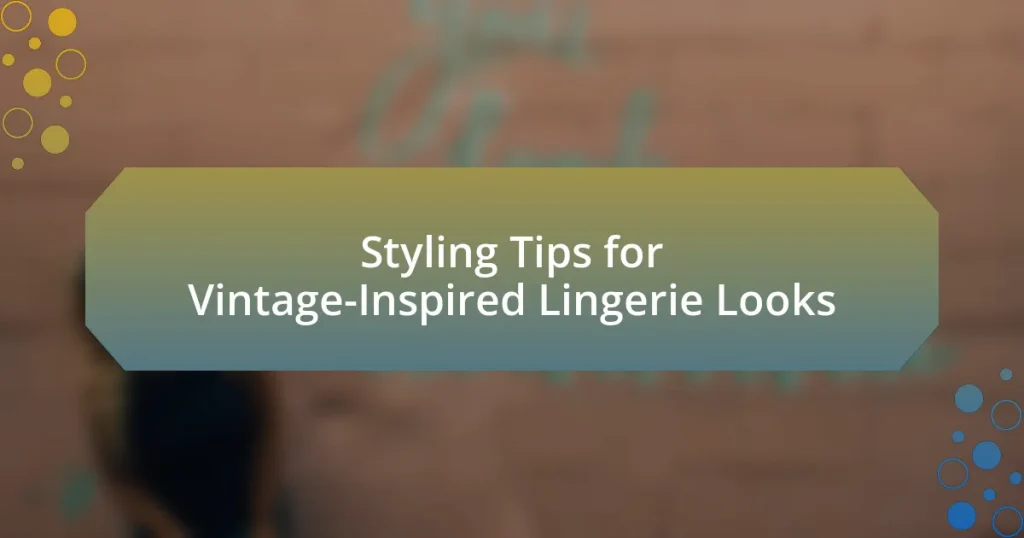Lingerie brands that prioritize body inclusivity are characterized by their diverse range of sizes, styles, and representations in marketing. These brands, such as Savage X Fenty and Aerie, extend their size offerings beyond traditional categories to include plus sizes and specialty sizes, while also featuring models of various ethnicities, body shapes, and ages. The article explores how these brands define body inclusivity, the specific body types they cater to, and the impact of representation on consumer confidence and brand loyalty. Additionally, it highlights strategies for consumers to identify and support inclusive lingerie brands, emphasizing the importance of diverse sizing options and ethical practices in the industry.

What are the key characteristics of lingerie brands that promote body inclusivity?
Lingerie brands that promote body inclusivity typically feature a diverse range of sizes, styles, and representations in their marketing. These brands prioritize offering products that cater to various body types, ensuring that their size ranges extend beyond traditional small to large categories, often including plus sizes and specialty sizes. For example, brands like Savage X Fenty have gained recognition for their extensive size offerings, which include sizes up to 3X and beyond, reflecting a commitment to inclusivity.
Additionally, these brands often utilize models of different ethnicities, body shapes, and ages in their advertising campaigns, which helps to challenge conventional beauty standards and fosters a sense of belonging among consumers. Research indicates that 67% of consumers feel more positively about brands that feature diverse models, highlighting the importance of representation in promoting body inclusivity. Furthermore, many inclusive lingerie brands emphasize body positivity in their messaging, encouraging customers to embrace their bodies and feel confident in their skin.
How do these brands define body inclusivity?
Brands define body inclusivity as the commitment to represent and cater to a diverse range of body types, sizes, and identities in their products and marketing. This approach often includes offering extended size ranges, showcasing models of various shapes and backgrounds, and promoting body positivity through campaigns. For instance, brands like Aerie and Savage X Fenty have gained recognition for their inclusive sizing and diverse model representation, which reflects a broader societal shift towards acceptance and celebration of all body types.
What specific body types do these brands cater to?
These brands cater to a diverse range of body types, including plus-size, petite, curvy, and athletic figures. For instance, brands like Savage X Fenty specifically design lingerie for sizes ranging from XS to 3X, ensuring inclusivity for various body shapes. Additionally, Aerie promotes body positivity by offering sizes up to 3X and featuring models of different body types in their campaigns, which reinforces their commitment to inclusivity. This approach not only addresses the needs of different body types but also reflects a growing trend in the lingerie industry towards embracing all shapes and sizes.
How do these brands ensure representation in their marketing?
Lingerie brands ensure representation in their marketing by featuring diverse models of various body types, ethnicities, and ages in their campaigns. For instance, brands like Aerie and Savage X Fenty have gained recognition for their commitment to inclusivity by showcasing models that reflect a wide range of sizes and backgrounds, thereby challenging traditional beauty standards. Research indicates that 67% of consumers prefer brands that promote diversity in their advertising, highlighting the effectiveness of this approach in resonating with a broader audience.
Why is body inclusivity important in the lingerie industry?
Body inclusivity is important in the lingerie industry because it promotes diversity and representation, allowing individuals of all shapes and sizes to feel seen and valued. This inclusivity addresses the psychological impact of body image, as studies show that positive representation can enhance self-esteem and body confidence among consumers. For instance, a survey by the American Psychological Association found that 70% of women reported feeling more confident when they see diverse body types in advertising. By embracing body inclusivity, lingerie brands not only cater to a broader market but also foster a culture of acceptance and empowerment, ultimately driving consumer loyalty and brand success.
What impact does body inclusivity have on consumer confidence?
Body inclusivity significantly enhances consumer confidence by fostering a sense of belonging and acceptance among diverse body types. When lingerie brands embrace body inclusivity, they create an environment where consumers feel represented and valued, leading to increased self-esteem and positive body image. Research indicates that 67% of consumers are more likely to purchase from brands that showcase diverse body types in their marketing, demonstrating a direct correlation between inclusivity and consumer purchasing behavior. This shift not only empowers individuals but also drives brand loyalty, as consumers are more inclined to support companies that align with their values of diversity and acceptance.
How does body inclusivity influence brand loyalty?
Body inclusivity significantly enhances brand loyalty by fostering a sense of belonging among diverse consumers. When lingerie brands embrace body inclusivity, they resonate with a broader audience, leading to increased emotional connections and trust. Research indicates that 67% of consumers are more likely to remain loyal to brands that represent diverse body types in their marketing (Dove’s “Real Beauty” campaign). This alignment with consumer values not only drives repeat purchases but also encourages positive word-of-mouth, further solidifying brand loyalty.

Which lingerie brands are leading the charge in body inclusivity?
Savage X Fenty, Aerie, and ThirdLove are leading the charge in body inclusivity within the lingerie industry. Savage X Fenty, founded by Rihanna, is known for its diverse range of sizes and models of various body types, promoting a message of empowerment and representation. Aerie, a sub-brand of American Eagle Outfitters, has gained recognition for its commitment to body positivity, featuring unretouched photos of models in its campaigns and offering a wide size range. ThirdLove emphasizes comfort and fit, providing half-sizes and a diverse array of styles to cater to different body shapes, further supporting the movement towards inclusivity in lingerie.
What are some notable examples of inclusive lingerie brands?
Notable examples of inclusive lingerie brands include Savage X Fenty, Aerie, ThirdLove, and Naja. Savage X Fenty, founded by Rihanna, offers a wide range of sizes and promotes body positivity through diverse marketing campaigns. Aerie, a sub-brand of American Eagle Outfitters, is known for its commitment to unretouched photos and a broad size range, emphasizing body acceptance. ThirdLove focuses on fit and comfort, providing half-sizes and a diverse selection of styles to cater to various body types. Naja combines inclusivity with sustainability, offering lingerie in a wide range of sizes while also supporting women artisans. These brands exemplify the movement towards body inclusivity in the lingerie industry.
How do these brands differ from traditional lingerie brands?
These brands differ from traditional lingerie brands by prioritizing body inclusivity and diverse sizing options. While traditional lingerie brands often focus on a narrow range of sizes and idealized body types, these inclusive brands offer a wider array of sizes that cater to various body shapes, promoting a message of acceptance and self-love. For example, brands like Savage X Fenty have been recognized for their extensive size range, which includes options for plus-size individuals, contrasting with the limited offerings of many conventional brands. This shift not only reflects changing consumer demands but also aligns with a broader cultural movement towards body positivity and representation in fashion.
What unique features do these brands offer for inclusivity?
Lingerie brands leading the charge in body inclusivity offer unique features such as diverse sizing, adaptive designs, and representation in marketing. For instance, brands like Savage X Fenty provide an extensive size range from XS to 3X, ensuring that individuals of all body types can find suitable options. Additionally, Aerie promotes body positivity by using unretouched images of models in their campaigns, showcasing real bodies and fostering a sense of belonging. Furthermore, brands like ThirdLove incorporate adjustable features in their bras, catering to various body shapes and needs, which enhances comfort and accessibility. These initiatives reflect a commitment to inclusivity, making lingerie more accessible and representative of all consumers.
What strategies do these brands use to promote body inclusivity?
Lingerie brands promote body inclusivity through diverse representation in marketing campaigns, offering a wide range of sizes, and using body-positive messaging. For instance, brands like Aerie and Savage X Fenty feature models of various body types, ethnicities, and abilities in their advertisements, which helps to normalize different body shapes and sizes. Additionally, these brands often provide extensive size ranges, ensuring that their products cater to a broader audience, which is evidenced by Aerie’s commitment to offering sizes from XXS to 3X. Furthermore, body-positive messaging is prevalent in their branding, with slogans and campaigns that celebrate self-love and acceptance, reinforcing the idea that all bodies are beautiful. This multifaceted approach not only enhances brand loyalty but also fosters a more inclusive culture within the lingerie industry.
How do they incorporate diverse sizing options?
Lingerie brands incorporate diverse sizing options by offering a wide range of sizes that cater to various body types, ensuring inclusivity for all consumers. For example, many brands provide sizes that extend beyond traditional small, medium, and large categories, including plus sizes and specialty sizes that accommodate different body shapes. This approach is supported by market research indicating that 67% of women in the U.S. wear a size 14 or larger, highlighting the demand for more inclusive sizing. By utilizing size charts that reflect real body measurements and conducting consumer feedback sessions, these brands can better align their offerings with the needs of their diverse customer base.
What role does customer feedback play in their product development?
Customer feedback plays a crucial role in product development for lingerie brands focusing on body inclusivity by directly informing design choices and enhancing customer satisfaction. Brands actively solicit feedback through surveys, social media interactions, and focus groups, allowing them to understand diverse body types and preferences. For instance, a study by the Journal of Fashion Marketing and Management found that brands that incorporate customer insights into their design process see a 30% increase in customer loyalty and sales. This data underscores the importance of customer feedback in creating products that resonate with a wider audience, ultimately driving innovation and market success in the lingerie industry.

How can consumers identify and support body-inclusive lingerie brands?
Consumers can identify and support body-inclusive lingerie brands by researching companies that prioritize diverse sizing, inclusive marketing, and ethical production practices. Brands like Savage X Fenty and Aerie have gained recognition for offering a wide range of sizes and featuring models of various body types in their advertising campaigns. Additionally, consumers can look for certifications or endorsements from organizations that advocate for body positivity and inclusivity, such as the Body Positive Movement. Supporting these brands through purchases and sharing their messages on social media further amplifies their commitment to body inclusivity.
What should consumers look for when choosing inclusive lingerie?
Consumers should look for diverse sizing options, quality materials, and representation in marketing when choosing inclusive lingerie. Diverse sizing ensures that a wide range of body types can find a comfortable fit, which is essential for body inclusivity. Quality materials enhance comfort and durability, making the lingerie suitable for everyday wear. Representation in marketing, including models of various sizes, shapes, and backgrounds, reflects a commitment to inclusivity and helps consumers feel seen and valued. Brands that prioritize these factors contribute to a more inclusive lingerie market, as evidenced by the growing demand for body-positive products and the success of brands that embrace these principles.
How can consumers research a brand’s commitment to inclusivity?
Consumers can research a brand’s commitment to inclusivity by examining its marketing materials, product offerings, and corporate social responsibility initiatives. Analyzing advertising campaigns for diverse representation, reviewing size ranges and styles available, and checking for partnerships with organizations that promote inclusivity can provide insights. Additionally, consumers can look for transparency reports or statements from the brand regarding their inclusivity goals and practices. Brands that actively engage in community discussions or support relevant causes often demonstrate a genuine commitment to inclusivity.
What certifications or labels indicate body inclusivity?
Certifications and labels that indicate body inclusivity include the “Body Positive” certification, which signifies a commitment to promoting diverse body types and sizes in marketing and product offerings. Additionally, the “Inclusive Size” label is awarded to brands that offer a wide range of sizes, catering to various body shapes. The “Diversity and Inclusion” certification recognizes companies that actively implement policies and practices to support body diversity within their workforce and customer base. These certifications are validated by organizations that assess adherence to inclusivity standards, ensuring that brands genuinely support body positivity and diversity in their offerings.
What are some practical tips for finding the right inclusive lingerie?
To find the right inclusive lingerie, prioritize brands that offer a wide range of sizes and styles to accommodate diverse body types. Look for companies that explicitly promote body positivity and inclusivity in their marketing, as this often reflects their commitment to catering to all customers. Research customer reviews and testimonials to gauge the fit and comfort of the lingerie, as real experiences can provide insight into how well the products meet various body needs. Additionally, consider brands that use diverse models in their advertising, which can indicate a broader understanding of body inclusivity.
How can consumers effectively measure themselves for the best fit?
Consumers can effectively measure themselves for the best fit by using a soft measuring tape to take key body measurements, including bust, waist, and hip sizes. Accurate measurements are crucial for determining the correct lingerie size, as sizing can vary significantly between brands. For instance, the International Journal of Fashion Design, Technology and Education highlights that proper measurement techniques can lead to a better fit and increased comfort, which is essential for body inclusivity in lingerie. Additionally, many lingerie brands provide detailed sizing guides and fitting instructions on their websites, which can further assist consumers in achieving the best fit.
What are the best practices for trying on and selecting lingerie?
The best practices for trying on and selecting lingerie include understanding your body shape, choosing the right size, and considering the fabric and style. First, knowing your body shape helps in selecting styles that enhance your natural curves; for example, A-line silhouettes suit pear shapes, while balconette bras flatter fuller busts. Second, accurate sizing is crucial; studies show that 80% of women wear the wrong bra size, which can lead to discomfort and poor fit. Measuring yourself or getting professionally fitted ensures you select the correct size. Lastly, consider the fabric and style; breathable materials like cotton are ideal for everyday wear, while lace or satin may be preferred for special occasions. These practices enhance comfort, confidence, and overall satisfaction with lingerie choices.















